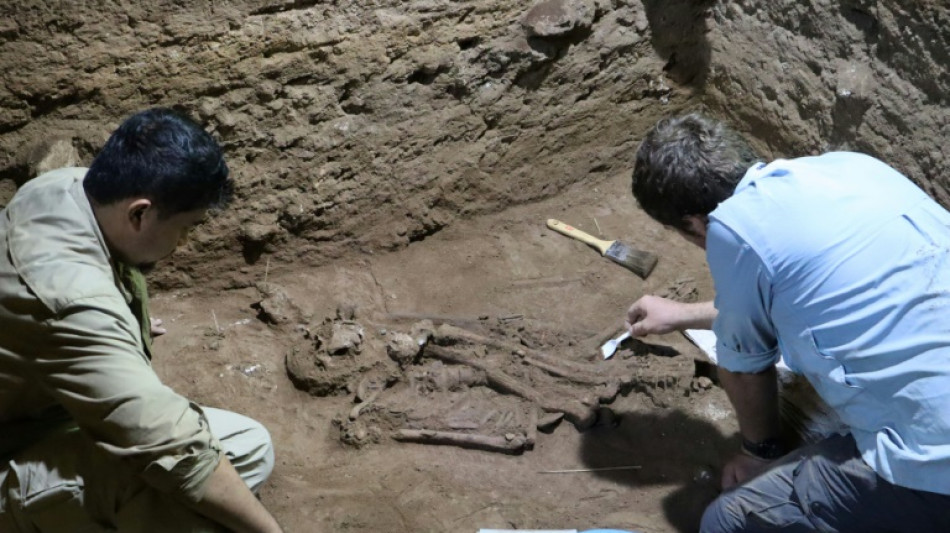
-
 As AI gets real, slow and steady wins the race
As AI gets real, slow and steady wins the race
-
China's Huawei to launch 'milestone' smartphone with homegrown OS

-
 Porzingis and Morant make triumphant NBA returns
Porzingis and Morant make triumphant NBA returns
-
Hong Kong top court affirms housing, inheritance rights for same-sex couples

-
 Philippines, China clashes trigger money-making disinformation
Philippines, China clashes trigger money-making disinformation
-
Most Asian markets drop, dollar gains as Trump fires tariff warning

-
 England 'not quivering' ahead of New Zealand Test challenge
England 'not quivering' ahead of New Zealand Test challenge
-
Bethell to bat at three on England Test debut against New Zealand

-
 Trump vows big tariffs on Mexico, Canada and China
Trump vows big tariffs on Mexico, Canada and China
-
New Zealand and England to play for Crowe-Thorpe Trophy

-
 Scheffler, Schauffele and McIlroy up for PGA Player of the Year
Scheffler, Schauffele and McIlroy up for PGA Player of the Year
-
Trump to face less internal pushback in new term: ex-commerce chief

-
 Extreme weather threatens Canada's hydropower future
Extreme weather threatens Canada's hydropower future
-
More than 34,000 register as candidates for Mexico judges' election

-
 Australia ban cycling's Richardson for life after UK defection
Australia ban cycling's Richardson for life after UK defection
-
Internal displacement in Africa triples in 15 years: monitor

-
 'Remarkable global progress': HIV cases and deaths declining
'Remarkable global progress': HIV cases and deaths declining
-
Social media firms raise 'serious concerns' over Australian U-16 ban

-
 Tiger to skip Hero World Challenge after back surgery
Tiger to skip Hero World Challenge after back surgery
-
MLB shifts six 2025 Rays games to avoid weather issues

-
 US women's keeper Naeher retiring after Europe matches
US women's keeper Naeher retiring after Europe matches
-
Dow ends at fresh record as oil prices pull back on ceasefire hopes

-
 West Ham stun Newcastle to ease pressure on Lopetegui
West Ham stun Newcastle to ease pressure on Lopetegui
-
Menendez brothers' bid for freedom delayed until January

-
 Arteta calls on Arsenal to show 'ruthless' streak on Champions League travels
Arteta calls on Arsenal to show 'ruthless' streak on Champions League travels
-
Israel bids emotional farewell to rabbi killed in UAE

-
 Sonar image was rock formation, not Amelia Earhart plane: explorer
Sonar image was rock formation, not Amelia Earhart plane: explorer
-
Tottenham goalkeeper Vicario has ankle surgery

-
 Prosecutor moves to drop federal cases against Trump
Prosecutor moves to drop federal cases against Trump
-
Green light for Cadillac to join Formula One grid in 2026

-
 Romania braces for parliamentary vote after far right's poll upset
Romania braces for parliamentary vote after far right's poll upset
-
US-Google face off as ad tech antitrust trial comes to close

-
 Special counsel moves to drop federal cases against Trump
Special counsel moves to drop federal cases against Trump
-
Israel to decide on ceasefire as US says deal 'close'

-
 California vows to step in if Trump kills US EV tax credit
California vows to step in if Trump kills US EV tax credit
-
Special counsel asks judge to dismiss subversion case against Trump

-
 Ronaldo double takes Al Nassr to brink of Asian Champions League quarters
Ronaldo double takes Al Nassr to brink of Asian Champions League quarters
-
Brazil minister says supports meat supplier 'boycott' of Carrefour

-
 Egypt says over a dozen missing after Red Sea tourist boat capsizes
Egypt says over a dozen missing after Red Sea tourist boat capsizes
-
Steelmaker ArcelorMittal to close two plants in France: unions

-
 Macy's says employee hid up to $154 mn in costs over 3 years
Macy's says employee hid up to $154 mn in costs over 3 years
-
Germany fears outside hand in deadly Lithuania jet crash

-
 EU grocery shoppers 'fooled' by 'maze' of food labels: audit
EU grocery shoppers 'fooled' by 'maze' of food labels: audit
-
Awaiting Commerzbank, Italy's UniCredit bids for Italian rival

-
 Alonso jokes about playing return amid Leverkusen injury woes
Alonso jokes about playing return amid Leverkusen injury woes
-
Stocks push higher on Trump's 'steady hand' for Treasury

-
 G7 ministers discuss ceasefire efforts in Mideast
G7 ministers discuss ceasefire efforts in Mideast
-
Bayern need to win all remaining Champions League games, says Kane

-
 Indian cricketer, 13, youngest to be sold in IPL history
Indian cricketer, 13, youngest to be sold in IPL history
-
Romania braces for parliament vote after far right's poll upset


Ancient skeleton reveals amputation surgery 31,000 years ago
A skeleton discovered in a remote corner of Borneo rewrites the history of ancient medicine and proves amputation surgery was successfully carried out about 31,000 years ago, scientists said Wednesday.
Previously, the earliest known amputation involved a 7,000-year-old skeleton found in France, and experts believed such operations only emerged in settled agricultural societies.
The finding also suggests that Stone Age hunter-gatherers living in what is now Indonesia's East Kalimantan province had sophisticated medical knowledge of anatomy and wound treatment.
"It rewrites our understanding of the development of this medical knowledge," said Tim Maloney, a research fellow at Australia's Griffith University, who led the work.
The skeleton was uncovered in 2020 in the imposing Liang Tebo cave known for its wall paintings dating back 40,000 years.
Surrounded by bats, terns and swiftlets, and interrupted by the occasional scorpion, scientists painstakingly removed sediment to reveal an astoundingly well-preserved skeleton.
It was missing just one notable feature: its left ankle and foot.
The base of the remaining leg bone had a surprising shape, with knobbly regrowth over an apparently clean break, strongly indicating that the ankle and foot were removed deliberately.
"It's very neat and oblique, you can actually see the surface and shape of the incision through the bone," Maloney told a press briefing.
Other explanations, like an animal attack, crushing injury, or fall, would have created bone fractures and healing different from those seen in the skeleton's leg.
A tooth and surrounding sediment showed the skeleton is at least 31,000 years old and belongs to a person who died at around 20 years old.
Despite the incredible trauma of amputation, they appear to have survived six to nine years after the operation, based on the regrowth on the leg bone, and suffered no major post-operative infection.
That suggests "detailed knowledge of limb anatomy and muscular and vascular systems," the research team wrote in a paper published Wednesday in the journal Nature.
"Intensive post-operative nursing and care would have been vital... the wound would have regularly been cleaned, dressed and disinfected."
- 'A hotspot of human evolution' -
Humans have been operating on each other for centuries, pulling teeth and drilling skull holes in a process called trepanation.
But amputation is so complex that in the West it only became an operation people could reasonably hope to survive about a century ago.
The oldest previous example was a 7,000-year-old skeleton with a forearm found in France in 2010.
It appeared to confirm that humans only developed sophisticated surgery after settling in agricultural societies, freed from the daily grind of hunting food.
But the Borneo find demonstrates hunter-gatherers could also navigate the challenges of surgery, and did so at least 24,000 years earlier than once thought.
For all that the skeleton reveals, many questions remain: how was the amputation carried out and why? What was used for pain or to prevent infection? Was this operation rare or a more common practice?
The team speculates that a surgeon might have used a lithic blade, whittled from stone, and the community could have accessed rainforest plants with medicinal properties.
The study "provides us with a view of the implementation of care and treatment in the distant past," wrote Charlotte Ann Roberts, an archeologist at Durham University, who was not involved in the research.
It "challenges the perception that provision of care was not a consideration in prehistoric times," she wrote in a review in Nature.
Further excavation is expected next year at Liang Tebo, with the hope of learning more about the people who lived there.
"This is really a hotspot of human evolution and archeology," said Renaud Joannes-Boyau, an associate professor at Southern Cross University who helped date the skeleton.
"It's certainly getting warmer and warmer, and the conditions are really aligned to have more amazing discoveries in the future."
B.Shevchenko--BTB



